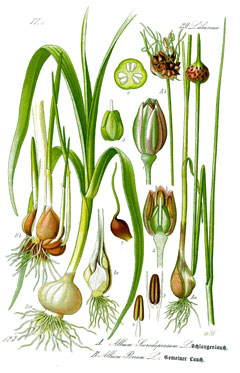 |
|
http://upload.wikimedia.org/wikipedia/commons/archive/8/8b/20061127004904!Illustration_Allium_scorodoprasum0.jpg |
 |
| http://commons.wikimedia.org/wiki/User:Fabelfroh |
Translate this page:
Summary
Physical Characteristics

 Allium_scorodoprasum is a BULB growing to 0.6 m (2ft) by 0.1 m (0ft 4in).
Allium_scorodoprasum is a BULB growing to 0.6 m (2ft) by 0.1 m (0ft 4in).
See above for USDA hardiness. It is hardy to UK zone 7 and is not frost tender. It is in flower from May to August. The species is hermaphrodite (has both male and female organs) and is pollinated by Bees, insects.
Suitable for: light (sandy) and medium (loamy) soils, prefers well-drained soil and can grow in nutritionally poor soil. Suitable pH: mildly acid, neutral and basic (mildly alkaline) soils. It cannot grow in the shade. It prefers dry or moist soil.
UK Hardiness Map
US Hardiness Map
Synonyms
Plant Habitats
Edible Uses
Bulb - raw or cooked[5, 46]. A garlic substitute[22, 27, 37, 61], it is used as a flavouring in salads, soups etc[238]. The bulbs are smaller than garlic and have a milder flavour, they are produced at the points of the stem as well as at the base[2]. The bulbs are 10 - 20mm in diameter[200]. Leaves - raw or cooked[238]. Used as a flavouring in salads etc[238]. Flowers - raw. Used as a garnish on salads.
References More on Edible Uses
Medicinal Uses
Plants For A Future can not take any responsibility for any adverse effects from the use of plants. Always seek advice from a professional before using a plant medicinally.
The plant is digestive and depurative[178]. The bulb is used in the treatment of abscesses, amoebic dysentery, bronchitis, cholera, dysentery, influenza, skin diseases and TB[218].
References More on Medicinal Uses
The Bookshop: Edible Plant Books
Our Latest books on Perennial Plants For Food Forests and Permaculture Gardens in paperback or digital formats.

Edible Tropical Plants
Food Forest Plants for Hotter Conditions: 250+ Plants For Tropical Food Forests & Permaculture Gardens.
More

Edible Temperate Plants
Plants for Your Food Forest: 500 Plants for Temperate Food Forests & Permaculture Gardens.
More

More Books
PFAF have eight books available in paperback and digital formats. Browse the shop for more information.
Shop Now
Other Uses
The juice of the plant is used as a moth repellent. The whole plant is said to repel insects and moles[20].
Special Uses
References More on Other Uses
Cultivation details
Prefers a sunny position in a light well-drained soil[1]. Thrives in poor dry soils[238]. The bulbs should be planted fairly deeply[1]. Many forms of this species produce numerous bulbils in the flowering head[203]. The plants can become very invasive by means of these bulbils[203]. The sub-species A. scorodoprasum jajlae and A. scorodoprasum rotundum do not produce bulbils[203]. Grows well with most plants, especially roses, carrots, beet and chamomile, but it inhibits the growth of legumes[18, 20, 54]. This plant is a bad companion for alfalfa, each species negatively affecting the other[201]. Occasionally cultivated, especially in Russia, for its edible bulb[183]. Members of this genus are rarely if ever troubled by browsing deer[233].
References Carbon Farming Information and Carbon Sequestration Information
Temperature Converter
Type a value in the Celsius field to convert the value to Fahrenheit:
Fahrenheit:
The PFAF Bookshop
Plants For A Future have a number of books available in paperback and digital form. Book titles include Edible Plants, Edible Perennials, Edible Trees,Edible Shrubs, Woodland Gardening, and Temperate Food Forest Plants. Our new book is Food Forest Plants For Hotter Conditions (Tropical and Sub-Tropical).
Shop Now
Plant Propagation
Seed - sow spring in a cold frame. Prick out the seedlings into individual pots when they are large enough to handle - if you want to produce clumps more quickly then put three plants in each pot. Grow them on in the greenhouse for at least their first winter and plant them out into their permanent positions in spring once they are growing vigorously and are large enough. Division in spring. Very easy, the plants divide successfully at any time in the growing season and the divisions can be planted straight out into their permanent positions if required.
Other Names
If available other names are mentioned here
Native Range
TEMPERATE ASIA: Turkey EUROPE: Denmark, Finland, United Kingdom, Norway, Sweden, Czechoslovakia, Austria, Switzerland, Germany, Hungary, Netherlands, Poland, Ukraine (Krym), Former Yugoslavia, Albania, Bulgaria, Romania, France
Weed Potential
Right plant wrong place. We are currently updating this section.
Please note that a plant may be invasive in one area but may not in your area so it’s worth checking.
Conservation Status
IUCN Red List of Threatened Plants Status :

Growth: S = slow M = medium F = fast. Soil: L = light (sandy) M = medium H = heavy (clay). pH: A = acid N = neutral B = basic (alkaline). Shade: F = full shade S = semi-shade N = no shade. Moisture: D = dry M = Moist We = wet Wa = water.
Expert comment
Author
L.
Botanical References
17200
Links / References
For a list of references used on this page please go here
Readers comment